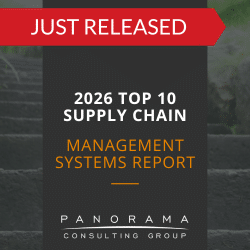Workplaces thrive on consistency. When everyone knows what’s expected of them and how to do their job, there’s less stress and better teamwork.
If that’s the case, then how should you approach a major change that’s going to shake up the status quo? By implementing change management, you can prepare your teams for new business processes or even new ERP, CRM, or SCM software.
Not sure how to approach this strategy? We’re sharing seven tips to help you get started.
7 Tips for Implementing Change Management
1. Prepare Your Approach
When you’re implementing change management, you might be tempted to start immediately. However, it’s important to take the time to prepare a change management approach.
We recommend establishing a change team and meeting with them to outline the steps you’ll take to mitigate employee resistance and facilitate a successful project.
Key questions to ask at this time include:
- What are we trying to achieve with this change?
- Who will have to do their jobs differently after this change?
- What will those differences look like?
- How will we define and track successful change?
Without these answers, it can be difficult to create an effective roadmap to change. You need to understand the full impact of change before you can confidently move forward.
Attention SAP, Oracle, Microsoft, and Infor Users!
Share your implementation story by taking our 7-minute survey. To show our appreciation, we'll send you a Starbucks gift card.
2. Conduct a Change Readiness Assessment
Another part of preparing your change approach is making sure an ERP implementation is the right move in the first place. Is your organization able to handle a shift of this magnitude? What are some of the implications you might experience if you start this project right now?
An organizational readiness assessment can help you look below the surface. For example, you can analyze who the main change detractors might be. These might be individual employees, sponsors, or other stakeholders who openly resist the change and convince others to do the same.
By identifying these individuals at the outset, you can put preemptive steps in place to make the transition as seamless as possible. If you don’t know where your potential problem areas lie, you might apply a generic change management approach that’s ineffective.
3. Create a Plan
Don’t just talk about what you’ll do throughout the change. Put those words into practice and create an actionable plan that everyone on your team can follow.
Within this plan, outline all the activities you will employ to support successful change, and consider the two most important change perspectives:
- The individual employee
- The entire organization
On an individual level, brainstorm how you will encourage employees to embrace the change. You might use the ADKAR model, which ensures that employees:
- Are aware of the change
- Have a desire to support the change
- Know how to change
- Have the ability to implement new skills and behaviors
- Will be responsive to your efforts to reinforce and sustain the change
On the organizational level, you should still apply the ADKAR model. However, you should do so on a much larger scale. Consider the steps you’ll need to implement to ensure your company as a whole is aware of the change and ready to embrace it.
4. Establish Sponsors
Successful change management requires input from your C-suite. You need executives who can put resources behind the effort. In addition, you need sponsors who can visibly champion the change.
When employees and department leaders see these influencers speaking confidently and enthusiastically about the change, they’re more likely to follow suit. This builds trust and gives employees a point of contact they can reach out to with questions and concerns.
Make sure all these designated leaders know what’s expected of them by creating sponsorship roadmaps tailored to each role and giving them the tools they need to do their jobs.
5. Communicate Strategically
Communication is 5% what you say and 95% how you say it. This is an integral part of organizational change management, and one that’s easy to overlook.
You can’t expect to keep your teams informed about the change by holding a handful of meetings. Instead, you need to tailor your communication strategy to appeal to each group.
Think about when you need to deliver each message as well as the wording and medium you’ll use to do so. How will you need to adjust your tone to address each core business group? Are there certain points you should focus on above others?
Overall, it helps to focus on the business case that’s driving the change, highlighting why it’s necessary and the benefits that everyone can expect once it’s in place.
A major component of successful communication is repetition. Instead of explaining a point once and never touching it again, repeat it in different ways and at different times to drive the point home.
6. Remove Barriers to Change
Sometimes, barriers to change are obvious. You can pinpoint one person who’s openly resisting and creating a stir. Other times, they’re more obscure.
Some of the most common obstacles that prevent successful change implementation include:
- Formal structures that prevent employees from acting on the change
- Lack of basic skills and training
- Outdated information systems
- Supervisors who don’t support the new vision
As soon as your team identifies an obstacle, take action to remove it immediately. This might mean training end-users to improve their competence or updating legacy systems and structures to support the new system.
7. Conduct Change Management Training
ERP system training is important, but many organizations fail to train on change management itself.
We recommend designing training that will equip your managers to understand, embrace, and spur change within their departments. Show them why change management is important, and work with them to understand how the new ERP software will affect their teams.
Change Management Success
Whether you’re installing a manufacturing ERP system, a CRM system, or a supply chain management system, successful change management is a collective effort that should be incorporated throughout your project timeline. This effort can make or break any enterprise-wide project, from an ERP implementation to a full-scale digital transformation.
If you need assistance implementing change management, our change management consultants are here to help. Contact us below for a free consultation.














